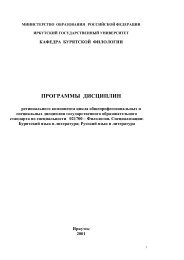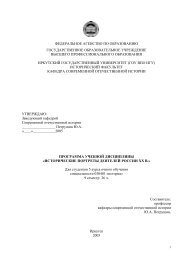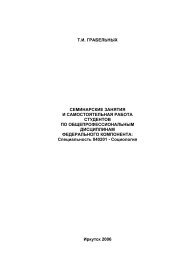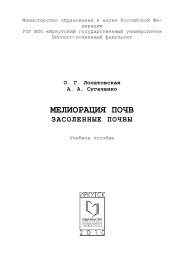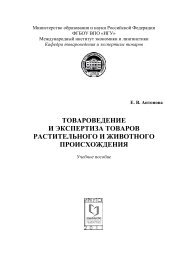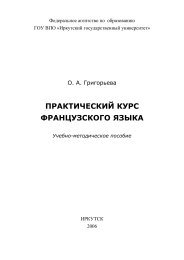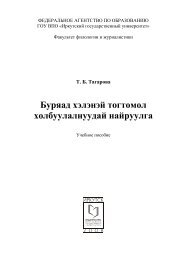Difference-differential Equations with Fredholm Operator in the Main ...
Difference-differential Equations with Fredholm Operator in the Main ...
Difference-differential Equations with Fredholm Operator in the Main ...
Create successful ePaper yourself
Turn your PDF publications into a flip-book with our unique Google optimized e-Paper software.
5 Examples<br />
Theorem 3 can be used for <strong>the</strong> statement and <strong>the</strong> <strong>in</strong>vestigation nonclassical boundary<br />
value problems for partial <strong>differential</strong> and difference equations <strong>with</strong> degeneration.<br />
1) Suppose that <strong>the</strong> coefficients a i (x, y), b i (x, y) of elliptic equation (∆ def<br />
= ∂2<br />
+ ∂2<br />
):<br />
∂x 2 ∂y 2<br />
(△+a 1 (x, y) ∂<br />
∂x +a 2(x, y) ∂ ∂y +a 3(x, y))Bu+( ∂<br />
∂x +b 1(x, y) ∂ ∂y +b 2(x, y))Au = f(x, y) (16)<br />
are def<strong>in</strong>ed <strong>in</strong> bounded doma<strong>in</strong> Ω ⊂ R 2 and belong to <strong>the</strong> space C l−2,α (Ω), l ≥ 2, α ∈<br />
(0, 1), f : Ω → E 2 belongs to <strong>the</strong> space C l−2,α (Ω). <strong>Fredholm</strong> operator B has a complete A<br />
-Jordan set, A is a compact operator.<br />
Let <strong>the</strong> doma<strong>in</strong> ω ⊆ Ω, ∂ω = l 1 ∪ ∂ 1 , where l 1 is <strong>the</strong> part of <strong>the</strong> straight l<strong>in</strong>e<br />
x = x 0 (fig.1).<br />
y<br />
✻<br />
✬<br />
✟<br />
✟ Ω<br />
✟<br />
✟ ∂<br />
✡ 1<br />
☎<br />
l 1<br />
❤❤❤❤❤ ✌<br />
✫<br />
x 0<br />
✩<br />
✪<br />
✲<br />
x<br />
Fig. 1. Example of a doma<strong>in</strong><br />
We shall consider <strong>the</strong> ”weakened” Dirichlet problem for equation (23) <strong>in</strong> <strong>the</strong> doma<strong>in</strong> ω,<br />
i.e. <strong>the</strong> problem of f<strong>in</strong>d<strong>in</strong>g function u, satisfy<strong>in</strong>g equation (23) <strong>in</strong> ω, and on <strong>the</strong> boundary<br />
∂ω <strong>the</strong> conditions<br />
u| x=x0 = φ 0 (y), (17)<br />
(I − P )u| ∂1 = φ 1 (x, y), (18)<br />
where φ 0 , φ 1 ∈ C l,α , P φ 1 = 0, (I − P )Φ 0 (y) = Φ 1 (x 0 , y), φ 0 , φ 1 ∈ D(B).<br />
Note that weaken<strong>in</strong>g <strong>the</strong> classical statement of <strong>the</strong> Dirichlet problem is that <strong>the</strong>re is<br />
no condition on projection P u along ∂ 1 of <strong>the</strong> boundary ∂ω. It is connected <strong>with</strong> that<br />
P u will be def<strong>in</strong>ed from <strong>the</strong> system of <strong>the</strong> first order.<br />
Based on <strong>the</strong>orem 1 <strong>the</strong> solution has form (4).<br />
If condition 4 is satisfied and l ≥ 2max 1≤i≤l p i <strong>the</strong>n based on <strong>the</strong>orem 3 problem<br />
(16)-(18) has <strong>the</strong> solution <strong>in</strong> <strong>the</strong> class C l,α (¯ω).<br />
Suppose that <strong>the</strong> homogeneous problem<br />
˜Lu ≡ (△ + a 1 (x, y) ∂<br />
∂x + a 2(x, y) ∂ ∂y + a 3(x, y))u + ( ∂<br />
∂x + b 1(x, y) ∂ ∂y + b 2(x, y))AΓu = 0,<br />
u| ∂ω = 0<br />
7




